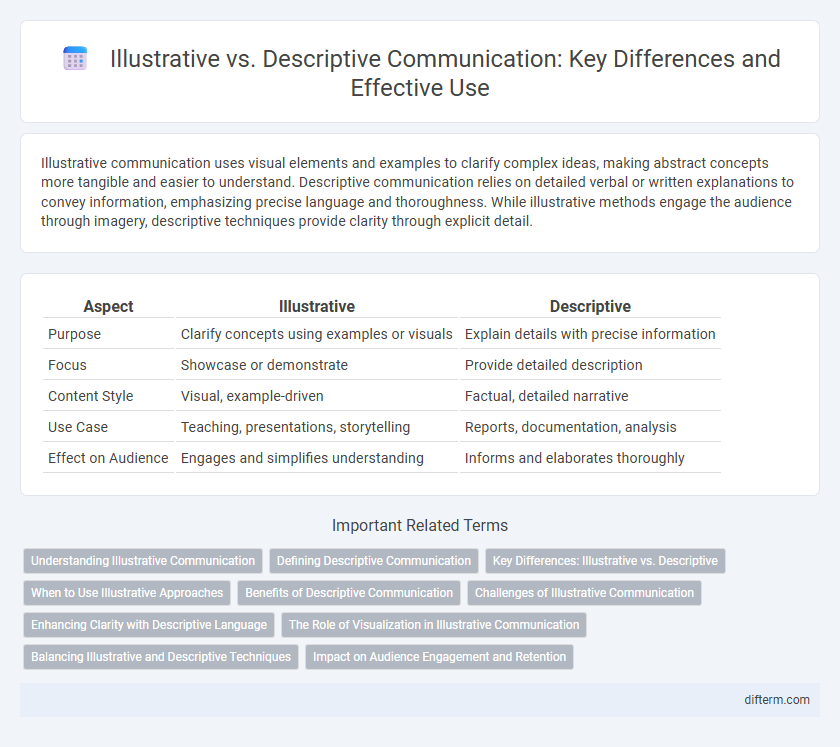Illustrative communication uses visual elements and examples to clarify complex ideas, making abstract concepts more tangible and easier to understand. Descriptive communication relies on detailed verbal or written explanations to convey information, emphasizing precise language and thoroughness. While illustrative methods engage the audience through imagery, descriptive techniques provide clarity through explicit detail.
Table of Comparison
| Aspect | Illustrative | Descriptive |
|---|---|---|
| Purpose | Clarify concepts using examples or visuals | Explain details with precise information |
| Focus | Showcase or demonstrate | Provide detailed description |
| Content Style | Visual, example-driven | Factual, detailed narrative |
| Use Case | Teaching, presentations, storytelling | Reports, documentation, analysis |
| Effect on Audience | Engages and simplifies understanding | Informs and elaborates thoroughly |
Understanding Illustrative Communication
Illustrative communication enhances understanding by using visual aids such as diagrams, charts, and images to clarify complex information. Unlike descriptive communication that relies solely on verbal or written explanations, illustrative methods engage multiple senses, improving retention and comprehension. Effective use of illustrative communication bridges gaps in knowledge by presenting abstract concepts in a concrete, easily digestible format.
Defining Descriptive Communication
Descriptive communication involves conveying information with clear, detailed observations that accurately represent a situation or object without injecting personal opinions or interpretations. This method prioritizes precise language and factual content to enhance understanding and reduce ambiguity. By focusing on objective description, it supports effective information exchange and clarity in both verbal and written communication.
Key Differences: Illustrative vs. Descriptive
Illustrative communication uses visual aids or examples to clarify concepts, enhancing understanding through imagery or demonstration, while descriptive communication relies on detailed verbal or written explanations to convey precise information. Illustrative methods engage the audience by showing relationships or processes, whereas descriptive techniques focus on portraying characteristics and attributes with accuracy. These key differences highlight how illustrations simplify complex ideas, contrasting with descriptions that emphasize thoroughness and specificity in communication.
When to Use Illustrative Approaches
Illustrative approaches are most effective when the goal is to simplify complex information through visual examples, such as diagrams, charts, or infographics, enhancing audience understanding and retention. These methods work best in presentations or educational content where concrete visuals can bridge gaps in knowledge or clarify abstract concepts. Using illustrative communication is particularly advantageous when addressing diverse audiences with varying levels of prior knowledge.
Benefits of Descriptive Communication
Descriptive communication enhances clarity by providing detailed and precise information that reduces misunderstandings and ensures messages are accurately interpreted. It fosters stronger connections through vivid explanations that engage the audience's senses and emotions, making content more relatable and memorable. This approach supports effective feedback and collaborative problem-solving by offering concrete examples and specific data for discussion.
Challenges of Illustrative Communication
Illustrative communication often faces challenges such as misinterpretation due to cultural differences and varying levels of visual literacy among audiences. The reliance on images or symbols can lead to ambiguity, especially when abstract concepts are involved or when visual elements lack sufficient context. Ensuring clarity requires careful design and testing to bridge gaps in understanding and avoid confusion.
Enhancing Clarity with Descriptive Language
Descriptive language enhances clarity by providing vivid details that help the audience visualize the message, making complex ideas more understandable. Unlike illustrative language that relies on examples or analogies, descriptive language paints a precise picture through specific adjectives and sensory information. This approach reduces ambiguity and strengthens comprehension, especially in technical or instructional communication.
The Role of Visualization in Illustrative Communication
Visualization plays a pivotal role in illustrative communication by transforming complex information into clear, engaging images that enhance understanding and retention. Through the use of charts, diagrams, and infographics, visualization simplifies data interpretation and supports effective message delivery. This approach leverages human cognitive abilities to process visual stimuli faster than text, making communication more impactful and accessible.
Balancing Illustrative and Descriptive Techniques
Balancing illustrative and descriptive techniques enhances communication effectiveness by combining vivid imagery with clear explanations to engage diverse audiences. Illustrative methods use metaphors, analogies, and visuals to create memorable content, while descriptive techniques provide precise details and factual clarity. Integrating both approaches helps convey complex ideas with emotional resonance and intellectual understanding.
Impact on Audience Engagement and Retention
Illustrative communication, using vivid images and examples, significantly boosts audience engagement by making messages more relatable and memorable. Descriptive communication provides detailed information that enhances comprehension but may require more effort to maintain attention. Combining both styles creates a balanced approach that strengthens retention and keeps the audience actively connected to the content.
illustrative vs descriptive Infographic

 difterm.com
difterm.com